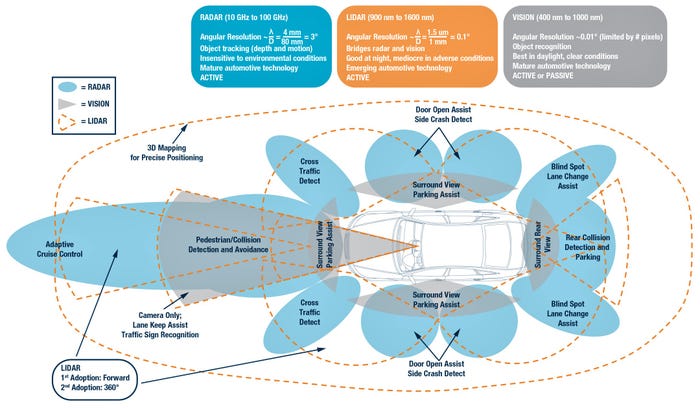From Driver Assistance to Driver ReplacementFrom Driver Assistance to Driver Replacement
No autonomous vehicle can be considered safe unless it is built upon a foundation of high-performance, high-integrity sensor signal chains, to consistently supply the most accurate data upon which to base life-or-death decisions.
October 15, 2019

From sensors to artificial intelligence (AI), the classic electronics supply chain has formed a collaborative matrix dedicated to making autonomous vehicles safe. Still, much needs to be done in hardware and software development to ensure drivers, passengers and pedestrians are protected.
While machine learning and AI have a role to play, their effectiveness depends upon the quality of incoming data. As such, no autonomous vehicle can be considered safe unless it integrates high-performance, high-integrity sensor signal chains to consistently supply the most accurate data upon which to base life-or-death decisions.
Cognitive Vehicles Foundational to Predictive Safety
To achieve fully cognitive autonomous vehicles, the number of sensors on the vehicle must increase significantly. Additionally, their performance and response times must greatly improve. Currently, higher degrees of automation are being achieved rapidly from sensor improvements that push the state of the art in advanced driver assistance systems. These technologies include cameras, lidar, radar, microelectromechanical systems, inertial measurement units (IMU), ultrasound and GPS.
With more sensors built into vehicles, they can better monitor and factor in current mechanical conditions, such as tire pressure and other factors that might affect braking and handling. With more external sensing modalities, the vehicle can become more fully cognitive of its surroundings.
Sensing modality advances allow an automobile to recognize the current state of the environment and be aware of its history. This ability can be as simple as awareness of road conditions or as detailed as types of accidents and how they occurred in a certain area over time. Historical data can be accessed and factored into real-time data from the vehicle’s sensors to provide increasingly accurate degrees of preventive action and incident avoidance.
For example, an IMU can detect a sudden bump or swerve indicating a pothole or an obstacle. Real-time connectivity allows this data to be sent to a central database and used to warn other vehicles of the hole or obstacle. This data is compiled, analyzed and fused so it can inform the vehicle’s forward-looking comprehension of the environment in which it operates. The vehicle then can act as a learning machine poised to make safer decisions compared with those of a human.

Sensor schematic

Sensor schematic
Multifaceted Decision Making and Analysis
Much needs to be done if various sensors will be viable solutions for problems facing the automotive industry. Cameras can calculate lateral velocity (the speed of an object traveling orthogonally to the direction of travel of the vehicle), but even the best machine-learning algorithms require ~300 ms to make a lateral-movement detection with sufficiently low false-alarm rates. For a pedestrian stepping in front of a vehicle moving at 60 mph (97 km/h), milliseconds make the difference between superficial and life-threatening injuries.
Similarly, radar has many advantages for speed and object detection, such as high resolution in elevation, as well as the ability to “see” around objects, but it too needs to improve to provide more time for the vehicle to react. Lidar is evolving into solid-state designs that can be placed at multiple points around the vehicle to support full 360-degree coverage, complementing radar and camera systems by adding higher angular resolution and depth perception for a more accurate 3D environment map.
GPS lets a vehicle know where it is, but it is not always available. In these situations, inertial measurement units can be fused with a high-definition map and perception sensors to provide the coverage needed to allow the vehicle to continue safely in its lane of travel.
High-Quality Data Saves Time and Lives
None of these sensing modalities matter if the sensors themselves are unreliable and their output signals aren’t captured accurately to be fed upstream as high-precision sensor data.
To achieve this, even the most advanced analog signal chains must be continuously improved to detect, acquire and digitize sensor signal outputs so their accuracy and precision do not drift with time and temperature. With the right components and design best practices, the effects of notoriously difficult issues such as interference and temperature can be greatly mitigated.
High-precision, high-quality data is fundamental to the ability of machine learning and AI processors to be properly trained and make the right decisions 100% of the time.
Chris Jacobs is vice president of Analog Devices’ Autonomous Transportation and Automotive Safety business unit.
About the Author
You May Also Like